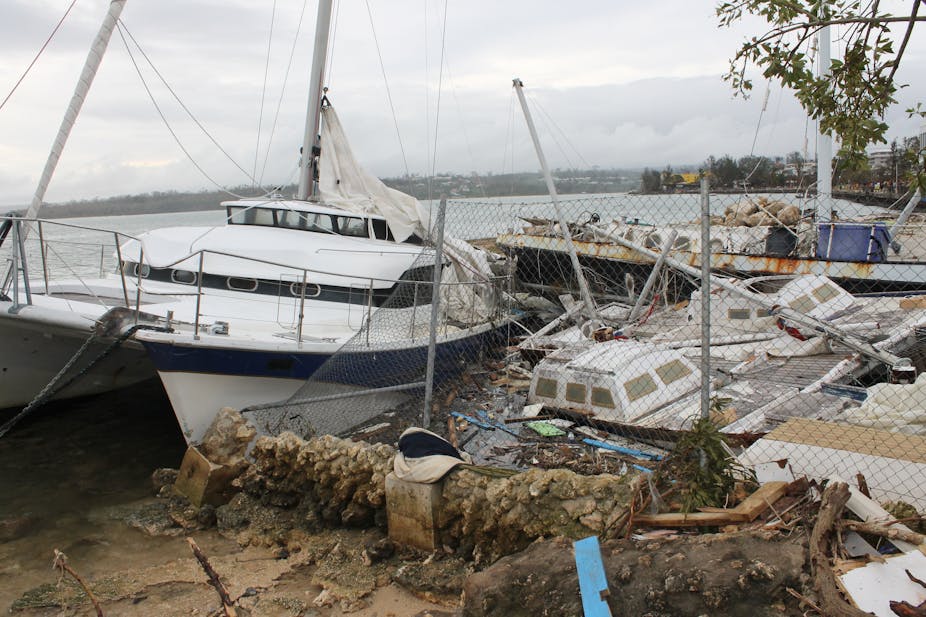As the clear-up following Cyclone Pam begins in earnest in Vanuatu, thoughts are beginning to turn to how to help this small island state recover from the disaster. Repairing damaged infrastructure such as homes, utilities, schools and shops is a vital first step. However, repairing the damage to livelihoods will take longer.
Vanuatu, like other small island states in the Pacific, is heavily dependent on tourism. In Vanuatu, tourism accounts for about 20% of GDP, with the remainder of the economy relying mostly on cash crops such as copra, and subsistence farming. Vanuatu has a total population of around 277,000, yet welcomes over 350,000 visitors each year. Around 110,000 fly in by air, with the bulk of the rest being day visitors arriving by cruise ship. But Cyclone Pam wreaked havoc and images of the devastation have been beamed around the world. Many of these visitors will be staying away for the foreseeable future. There is also no point in trying to persuade visitors to come back before the local people are ready to welcome them.
Helping disaster-struck destinations to recover their visitor numbers is a key part of ongoing economic recovery. Australia and New Zealand are by far the biggest source markets for Vanuatu. The island nation’s tourism industry is now faced with the challenge of convincing these tourists that Vanuatu is willing and able to offer an enjoyable holiday experience.
This challenge is intensified by media images of devastation and destruction. While it plays a crucial role in drawing awareness to the crisis, the media also shapes tourist perceptions about the destination that can be long-lasting.
For instance, media coverage of the impact of Cyclone Pam on Vanuatu is likely to have caused concern among tourists who have existing travel plans. Resorts and travel companies are currently dealing with cancellations and postponements. It is possible that in the tourist’s mind the entire destination is closed for business, despite the fact that some resorts and tourist areas remain fully operational. The enduring images of devastation could deter tourists for up to twelve months. So how can Vanuatu’s tourism industry counter these negative perceptions and restore their destination image?
We recommend a number of recovery marketing strategies that may assist Vanuatu to attract tourists in the aftermath of Cyclone Pam.
Destination marketing authorities and operators should focus their initial promotional efforts on those who have previously visited Vanuatu. Past and frequent visitors are more likely to return sooner than those who have not previously visited. Loyal visitors are also more likely to be understanding of any disruptions associated with the recovery process.
According to research we did on the impact of the 2011 Queensland floods, tourists are likely to be motivated by altruism when considering whether to visit a destination struck by disaster. When seeking to encourage tourists in the immediate future, messages that communicate the importance of tourism to the nation’s recovery may appeal to potential visitors.
Some tourists might be reluctant to visit Vanuatu for fear of getting in the way of recovery and there is no point in trying to persuade them to visit before the local people are ready to welcome them. However, once the community is showing signs of recovery, marketing messages that promote the community’s readiness and willingness to welcome visitors will counter these concerns.
The majority of tourists, in particular those with limited experience of Vanuatu, may be confused as to what resorts and attractions remain accessible and open for business. Those considering travelling to Vanuatu will also have concerns regarding accessibility. It is therefore important to keep tourists up to date with factual information about the status of the destination and the tourist experiences Vanuatu is able to offer. Social media sites should also be closely monitored to address the concerns of incoming visitors.
Following a disaster, it is common for operators to offer discounts and special rates as a way of encouraging tourists. However, discounting tour packages and accommodation rates may simply reinforce negative perceptions by suggesting that the tourist experience may be jeopardised. Offering added value such as complementary breakfast or stay five nights pay for three is a better option.
Tourism will play a vital role in the economic recovery of Vanuatu. One of the best things people can do to help the people of Vanuatu get back on their feet is to make this island nation their next holiday destination.

